Podiatrists Share What They'd Never Do (And Wish You Wouldn't Either)
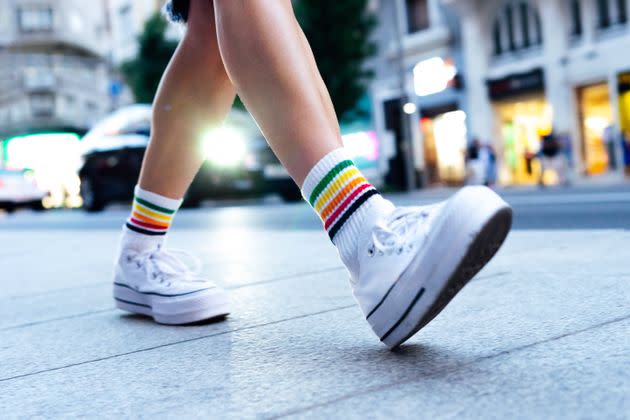
A few lifestyle habits can make or break your feet.
Foot issues can be particularly debilitating. Think about how often most of us need to use our feet throughout the day as we move from point A to point B.
That’s why it’s important to do what we can to keep our feet healthy and functioning — including avoiding certain footwear and behavior.
“As a podiatrist, we literally see the worst of the worst foot cases,” Dr. Ebonie Vincent, a board-certified podiatric foot and ankle specialist in California, told HuffPost. “Naturally there are things we would refrain from doing knowing what we know.”
Below, Vincent and other foot and ankle health experts share the behaviors they avoid in order to protect their foot health.
Wearing Crocs Everywhere
In recent years, Crocs have come back into style — to many podiatrists’ chagrin.
“Don’t get me wrong, Crocs are a decent shoe to wear around the house or while doing small tasks,” Vincent said. “However, when I see people wearing Crocs at Disneyland or for long hours of standing, I know they will probably suffer from some foot issues down the line.”
She recommended wearing “a good walking shoe” from brands like Brooks, Asics or New Balance for long days of standing or walking.
Living In High Heels
“Women who live in high heels will eventually suffer from foot pain from bunions, corns, heel spurs or even Achilles tendon pain,” Vincent said.
Plenty of people enjoy putting on high heels for special occasions, so wearing these shoes is not a “never” behavior. Still, a healthy balance is crucial. We’re not Barbie, after all.
“You should wear high heels [in] moderation, not the entire day or every day,” said Dr. Jason Gold, a board-certified podiatrist at the Foot, Ankle & Leg Vein Center in Florida. “Wearing high heels causes your foot to go into pronation, which can lead to bunions, hammer toes or plantar fasciitis.”
In general, he tells patients with foot pain to wear a supportive shoe at least 80% of the time. For the other 20%, they can wear whatever shoe they’d like. He noted that platform heels can help alleviate stress on the foot and muscles on the leg.
Walking Around Barefoot
“During COVID, people began to work at home a lot more than ever,” Gold said. “I found this caused more foot and ankle issues because people stopped wearing shoes as often.”
He recommended having a pair of supportive sneakers to wear when walking around at home, especially if you’re on tile and marble more than carpet. You can buy a “house”-specific sneaker for indoor use only if you’re concerned about bringing in germs from the outside.
“Time and time again, we hear that people live on their bare feet and are supposedly comfortable that way,” Vincent added. “If you consistently don’t provide support for your feet, you will develop calluses or even fat pad atrophy. If this happens, walking barefoot will no longer be comfortable, and you will limit your options on which shoes you can wear in the future.”
Running In Non-Running Shoes
“Avoid running in shoes that are not running shoes,” said Atlanta-based podiatrist Dr. Jay Spector. “Many people will get a cheap pair of shoes and try running, and that can create pain.”
He recommended changing your running shoes every 300-500 miles or every six to eight months.
“Also, wear the right shoe for the right activity,” Spector added. “Avoid wearing running shoes to play tennis and vice versa.”
Dr. Michael J. Trepal, a professor of surgery and academic dean at the New York College of Podiatric Medicine, warned against wearing zero-drop shoes (in which your heel is not raised, but on the same level as your toes) or running barefoot.
“Not only can a bare foot subject the skin on the bottom of the foot to injury, but [it] also supports poor mechanics against a non-deforming ground,” he said.
Going Barefoot In Hotel Bathrooms And Other Germy Spaces
Even if the idea of going barefoot in the bathroom at a gym, hotel or another public place doesn’t gross you out, podiatrists would still advise against it.
“I never walk barefoot in a hotel or take showers without flip-flops to avoid chances of wart/verruca or foreign body exposure,” Gold said. “Walking barefoot in a hotel or public places increases your chances of obtaining a virus on your feet, which is known as a plantar’s wart or verruca. Warts can multiply and come quite large on the foot and are sometimes difficult to remove.”
Wearing Cotton Socks
The fabric of your socks can also make a difference in terms of foot health, Spector noted.
“Avoid wearing cotton socks, as they retain moisture and can cause blisters and foot and nail fungus,” he said. “Stick to the synthetic materials, as they wick out sweat and moisture.”
Going To Untrusted Nail Salons
“I would never go to a salon that doesn’t sterilize their instruments after usage, which helps avoid chances of fungal or bacterial infections,” Gold said. “Fungal infections will cause your nails to become severely thickened and discolored with time.”
Ensure you’re going to salons that follow hygiene and cleanliness standards you can trust.
“Do not ... soak your feet at a pedicure without a liner, and make sure you see them open instruments that have been in an autoclave,” Spector said. “We see a lot of what I call ‘post-pedicure syndrome’ where we have seen MRSA staph infections, ingrown nails and foot cellulitis.”
Self-Treating Or Ignoring Infections
“I would not recommend using products such as Outgrow for ingrown toenails, as it is an acid that can lead to greater infections,” Spector said. “Also, with an infection such as an ingrown toenail, I would not swim in a lake or river where you don’t know what the E. coli levels are running.”
Trepal similarly advised against self-treating ingrown toenails due to the risk of infection and other complications.
“I also wouldn’t ignore foot pain because it could be a sign of something more serious,” he added.
Not Retying Laces
“Especially in pediatric patients, I would avoid not opening laces and retying them when putting on,” Trepal said. “The support function of the shoe is lost or greatly reduced in an unlaced or under-laced shoe.”
He noted that this is especially true with a flat or low-arch foot type, as those are prone to developing symptoms with inadequate support.
Forgetting To Take Extra Care As A Diabetic
“Those with diabetes should never go barefoot,” Vincent said. “This is because diabetes can damage the nerves in your feet. Not wearing shoes puts you at risk for injuries to the bottom of your feet that you may not feel due to loss of sensation from nerve damage. About 1 in 5 people with diabetes who go to the hospital do so for foot problems.”
She recommended inspecting your feet daily and wearing supportive shoes that fit properly to prevent complications.
“I would receive periodic professional foot exams if I suffered from diabetes or poor circulation,” Trepal said, adding that he would also never use a heating pad or place his feet on a radiator if he had these conditions, as the limited sensation means an increased risk of burning your feet.
Looking for the best walking shoes? These comfy shoes keep older folks in mind with features like orthopedic support, roomy toe boxes and Velcro straps, and they’re recommended by podiatrists.
HuffPost may receive a share from purchases made via links on this page. Every item is independently selected by the HuffPost Shopping team. Prices and availability are subject to change.
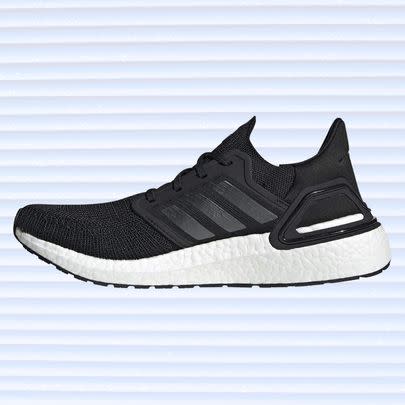
Amazon
Men's Adidas Ultraboost 20 sneaker
Perkins recommended this Adidas option, which is made from recycled plastics and has supportive interior padding and great grip on the sole. It comes in men's sizes 4-17 and in multiple colors, including black, orange, black/purple, gray/mint and white. It has a sock-like fit and a "boosting" feature, a super responsive midsole that makes it easier to take steps.
Promising review: "Extraordinarily comfortable shoe. I have flat feet, getting older with hip creaks here and there. My legs and joints feel great when wearing these shoes. Ultraboost is impressive stuff." — Amazon customer
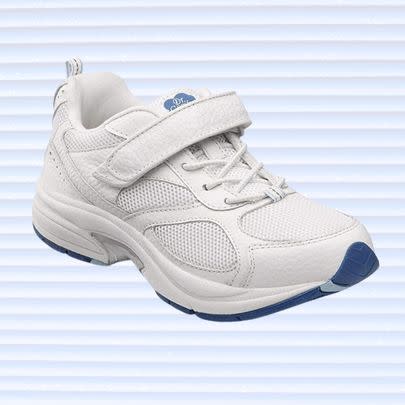
Amazon
Women's Dr. Comfort Victory shoe
This Dr. Comfort shoe checked off multiple boxes on Perkins' list of things to look for when buying a shoe for older adults, including its spacious toe box, lightweight design and Velcro strap.
"The most common complaint I hear from my senior patients is that a shoe is too heavy for them to wear comfortably. Any no-tie, slip-on or Velcro design that allows easy on and easy off is also great for seniors who have a hard time bending over," she said.
The adjustable strap closure allows you to get a more customized fit. The design also has a protective toe box that can help prevent pain from toe stubbing. It comes in white and pink and in women's sizes 4-12 with wide and extra-wide options.
Promising review: "I have problems with width in shoes. This fits better than expected. Comfortable in toe box and I even have a skip in my step thanks to the heel shock absorbing the bounce. Easy to put on with the velcro strap as the sole support to hold the shoe in place. Do not skip owning these shoes!" — snoopymaven
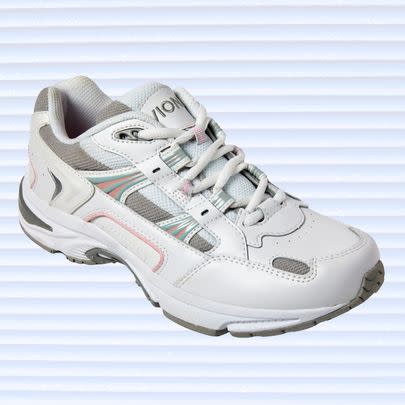
Vionic
Vionic Walker classic shoe
Stamped with the American Podiatric Medical Association Seal of Acceptance, this Vionic shoe is another recommendation from Perkins. It's breathable, has a podiatrist-designed footbed, cushioned outsole and a rubber outsole built for steady traction. It comes in several color options and is available in women's sizes 5-12 and men's sizes 7-14.
Promising review: "I received Vionic sneakers for Christmas. I wear a wide with in shoes and was skeptical that the shoes would fit well. I wore them for one day and noticed a marked decrease in my hip pain. I am thrilled with these shoes." — jrg
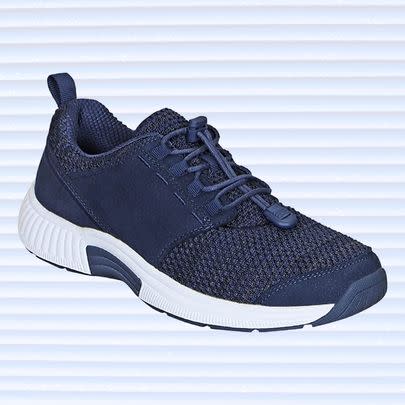
Amazon
Women's Orthofeet Francis walking shoe
Available in multiple colors, including blue, pink, maroon, gray and black, this walking shoe has a cushioned footbed and orthotic insole designed to help those with various foot conditions such as plantar fasciitis. It also has a roomy toe box for added comfort and bunion and hammertoe relief.
"The slip-on design makes it perfect for seniors who have a hard time bending over to tie a shoe or for those with arthritis in the hands who find difficulty with tying laces," Perkins said.
It comes in women's sizes 5-12, with narrow, wide and extra-wide and extra-extra-wide options.
Promising review: "I bought these walking shoes for my sister's birthday. She just turned 69 years old last week and she called me today to say that she thought these shoes were the best shoes she had ever put on. She has bad feet and see's a podiatrist on a regular schedule. She said she can wear them all day and not feel any foot pain." — Tony A.
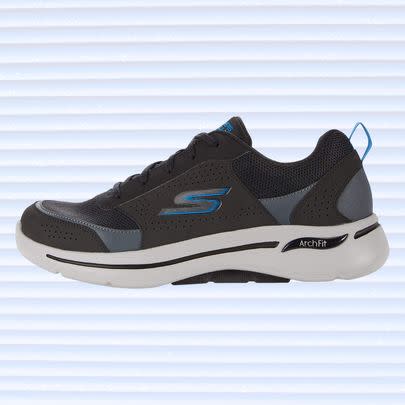
Zappos
Skechers Go Walk Arch Fit sneaker
Dr. Mireille Blanchette, a board-certified podiatrist based in New Jersey, recommended this lace-up Skechers sneaker because of its comfort and the fact that it's machine washable to help prevent bacteria buildup.
"Elders can sometimes develop foot fungus because they might not always be able to clean well between the toes and that can create a great environment for fungus," she said.
The shoe is designed with a pull tab on the back to make it easier to put on and take off and is lined in breathable fabric to promote air circulation. It comes in multiple colors and in women's sizes 5-12 and men's sizes 7-15, both with wide options available.
Promising review: "Bought these shoes for my mom. She needed something with good support that was energizing and helped with footing and movement. These shoes did the job. Her footing, posture and movement have improved tremendously. I bought them for her because I own a pair and have excellent wear with them." — Mom
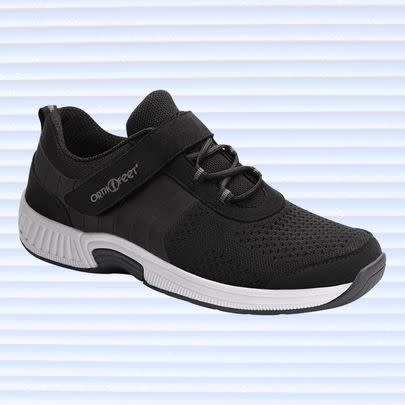
Amazon
Women's Orthofeet Joelle shoe
Blanchette also recommended this Velcro strap Orthofeet shoe, which comes with an adjustable arch booster you can add to increase arch support and several layers of supreme cushioning for maximum comfort. The shoe is also made of a stretchy knit fabric that's made to conform to your foot shape for a more personalized fit.
It comes in black and gray and in women's sizes 5-12, with wide, extra-wide and extra-extra-wide options available.
Promising review: "This shoe was purchased with my 90 yr old Mother in mind. She wanted something light weight , but sturdy & supportive, easy to put on, equally so to take off. She just didn’t want a pair of typical clunky tennis shoes. These have met her every expectation!" — GlitzyGiGi
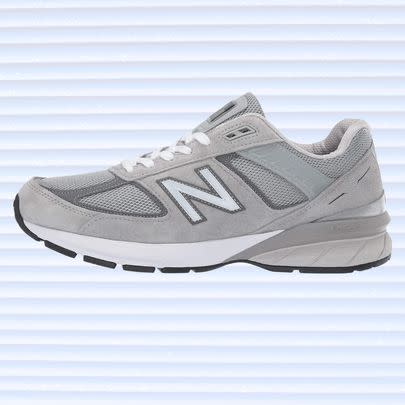
Zappos
New Balance 990v5 shoe
For a shoe that offers stability and supportive cushioning, look no further than this New Balance shoe recommended by Dr. Gary Evans, a podiatrist based in New York City. It has a breathable lining, durable rubber outsole and a footbed that provides proper cushioning and arch support. It comes in black, gray and navy and in women's sizes 5-13 and men's sizes 7-16.
Promising review: "This is my 8th pair of 990's! Wife and I are "exercise walkers". We are now older and are x-triathletes. Aerobic paced walking of 3-7 miles per day is what we enjoy. My 990's are fantastic for preventing injuries and providing a comfortable walk." — No N
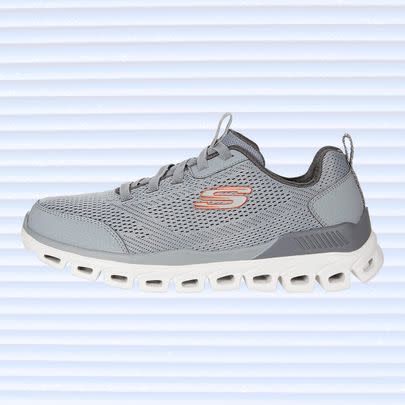
Zappos
Skechers Glide Step shoe
This lace-up shoe is made of breathable mesh and has a removable Skechers Arch Fit insole. It comes recommended by Evans and even has a podiatrist-designed shape to give you the most comfortable fit for all-day wear. The Skechers Glide-Step feature helps to give you a natural momentum as you take each step. It comes in multiple colors and in women's sizes 5.5-11 and men's sizes 7-10.5.
Promising review: "Absolutely the most comfortable shoes I've ever worn. I have diabetic neuropathy, and finding a comfortable shoe has been a ongoing quest. Sketchers has always been the most comfortable, but these "Glide Step" shoes are more comfortable than my bedroom slippers. What more can I say." — Anonymous
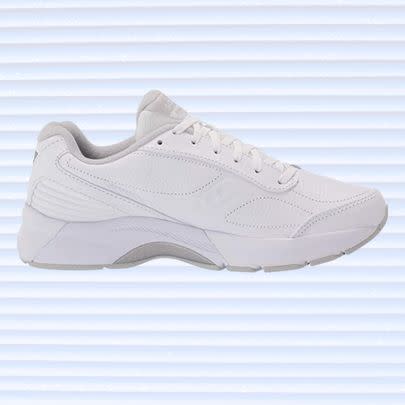
Amazon
Saucony Omni Walker 3 shoe
This classic, minimalist walking shoe recommended by Evans has all the features your feet need to stay comfy throughout the day, including a lightweight insole, rubber soles for good grip and a full-grain leather upper. It comes in white and black and in women's sizes 5-12 and men's sizes 7-14, both with wide options available.
Promising review: "I love these shoes. The support for the foot and ankle is extraordinary. My legs don’t feel fatigued when I wear these shoes. My back and hips don’t hurt either. I have rheumatoid arthritis, a repaired tendon in my knee and a small tear in an ankle (I know right...) but these shoes make me feel well supported when walking and comfortable. I highly recommend." — Aunie
